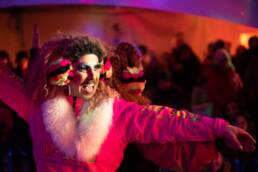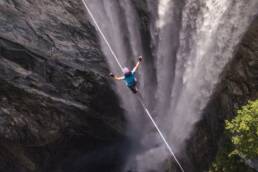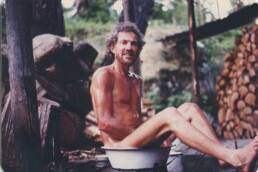Fashion icon Coco Chanel once said the best way to lose your cares is to be someone, not something. As our senior writer discovers, these drag performers are sharing that message with people of all ages. Story and photos by Louis Bockner.
In a living room in Nelson, three people stare into mirrors while a baby crawls across a glitter-flecked floor. The two men, Lev Sonego and Alex Pilon, are moustachioed, while the woman, Marjorie Jade Ménard, is beginning to paint on her own whiskers with careful yet confident strokes. Together they make up the Dancing Legs, a gender-bending performance group that has reinvigorated drag culture in this mountain town. When they take to the stage, song and dance merge with moustaches and stilettos to create a high-energy act. Depending on the crowd, it can be erotic with a capital R or rated E for everyone. To a degree, even the baby is a star. “I performed with Max in my belly six times,” says Ménard as she applies glue to fake eyelashes, “and the last one [I] was 32 weeks pregnant in an altered cat suit.”
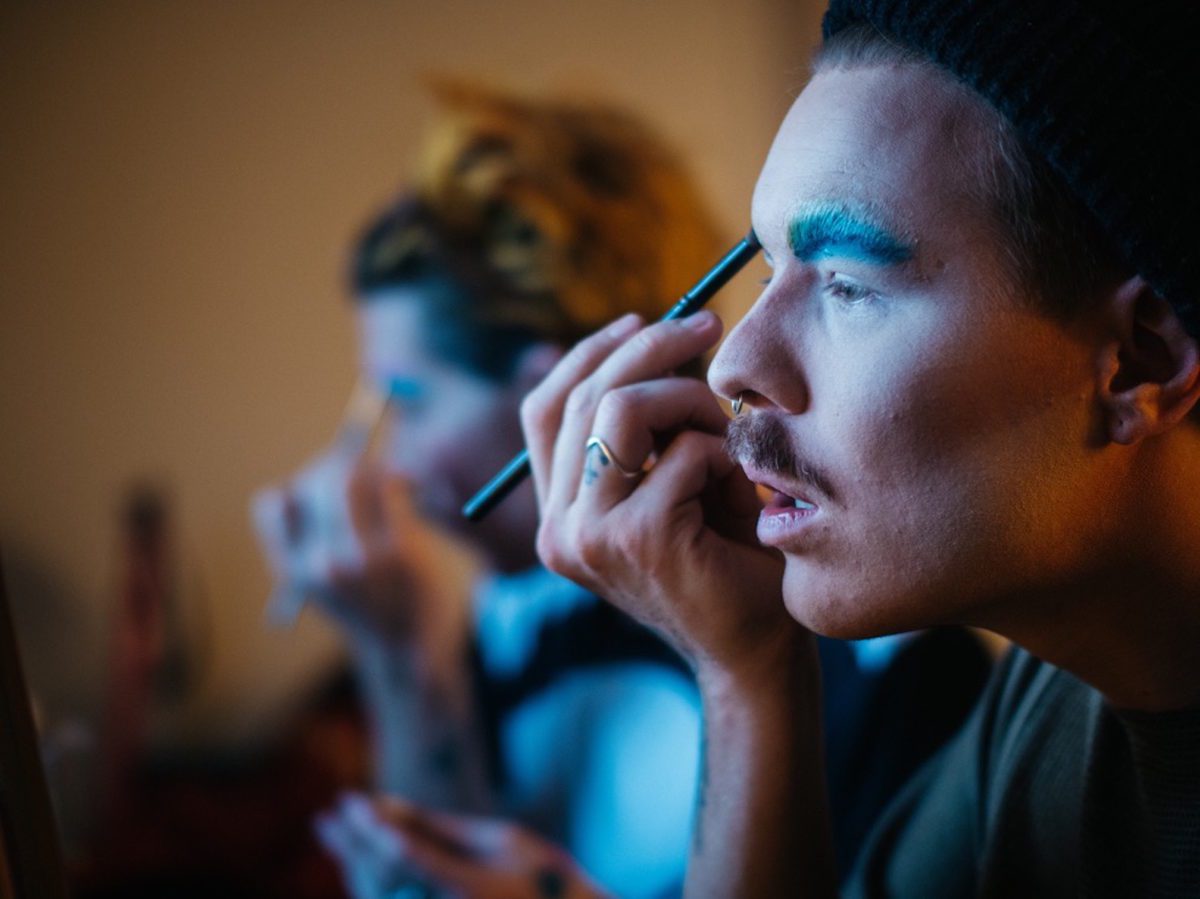
In three years, the trio has brought the Dancing Legs from a one-off performance at an annual burlesque show to a prominent fixture in Nelson’s eclectic performance landscape. Along with producing seven nightclub shows in their What a Drag series, they have expanded into all-ages events, something they believe fosters respect and compassion for the LGBTQ+ community. “Realizing that we could make our shows appropriate for kids was a big thing,” says Sonego. “Doing community events makes [people] realize that drag doesn’t just belong in bars on Saturday nights.”
This general shift to public spaces has emerged slowly, hand-in-hand with a wider acceptance of the LGBTQ+ community across the globe. Drag icons like Marsha P. Johnson—a leading figure of the 1969 Stonewall Riots that were a catalyst of the gay liberation movement—and RuPaul, whose popular reality TV show, RuPaul’s Drag Race, has inspired millions of would-be drag superstars, including the Dancing Legs—have worked for decades to bring drag into the mainstream.
Another drag act in Nelson is Jose and Cuervo, the latter being played by Jordyn Penry, who sees this normalization of drag as a key step to ending the marginalization of the LGBTQ+ community. “There is a beauty with people bringing their kids to these events because it informs and shapes the adults of tomorrow,” says Penry. “If kids are exposed to this, the world is going to change rapidly as they grow.” Jose, or Renee Letourneau, as she’s known when she’s not wearing a drawn-on black goatee, agrees, adding that people’s fears of drag being inappropriate for kids are often flawed. “Because gender is wrongly lumped in with sexuality, people really do think that if you’re challenging gender you’re going to be raunchy,” she says. “Really, the way your gender associates has nothing to do with how sexual you are.”
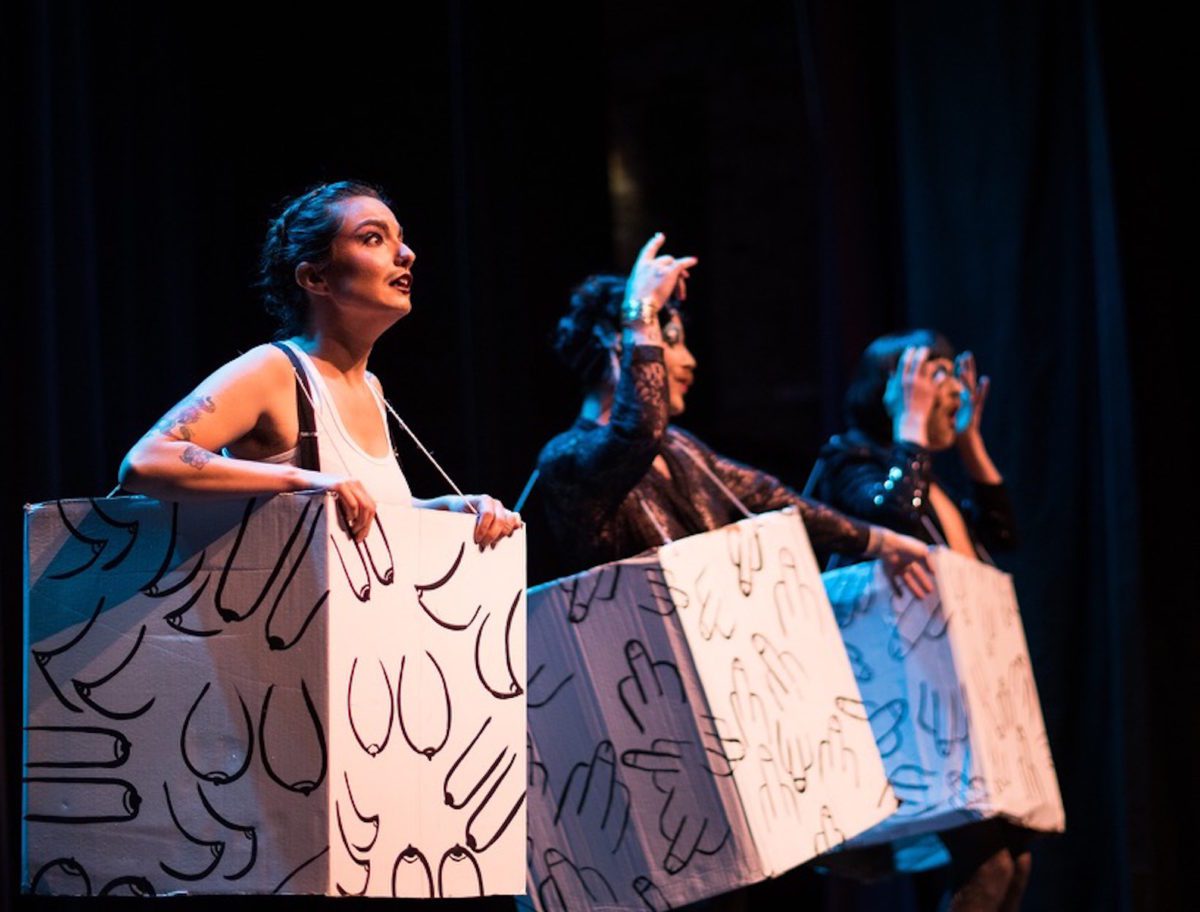
The Dancing Legs were reminded of the continued prevalence of these beliefs when they teamed up with the City of Trail’s Charles Bailey Theatre to put on a drag workshop and performance for youth. Backlash was swift. On the morning of the performance, police phoned the theatre to warn that the event might be disrupted by protestors, some of whom believed the workshop’s goal was to turn children gay. The Dancing Legs didn’t back down and the protestors never came. Instead, what unfolded was the most successful event in the theatre’s history: 575 people showed up to support the 17 youth on stage.
“All we heard about afterward was love and acceptance,” says Ménard. “It really shined a light on being who you want to be and showing it to the world. Especially as a new mom, it was just so beautiful.” Pilon nods in agreement. “We want to show these kids that the sky is the limit, that they can be themselves,” he says. “It doesn’t hurt anybody to put a wig on.”
Backlash was swift. On the morning of the performance, police phoned the theatre to warn that the event might be disrupted by protestors.
In the end, for both the Dancing Legs and Jose and Cuervo, drag is a form of expression as much as a tool for breaking down barriers. “It’s beautiful because you can express pain, comedy, theatrics, costuming, music, and dance all under the umbrella of identity,” explains Letourneau.
 Back in their makeshift dressing room, Sonego, Pilon, and Ménard are putting the final touches on their personas for a performance at Winter Kickoff, a Nelson event geared toward families that celebrates the snow-filled season ahead. Frizzy-haired wigs are set in place, knee-high boots are laced up, and retro skiwear completes the transformation. “RuPaul says it every episode,” Sonego says, “‘if you can’t love yourself, how is anyone else going to love you?’ I think drag is the key to that for a lot of queer people. For me personally, it’s been a way to face myself.”
Back in their makeshift dressing room, Sonego, Pilon, and Ménard are putting the final touches on their personas for a performance at Winter Kickoff, a Nelson event geared toward families that celebrates the snow-filled season ahead. Frizzy-haired wigs are set in place, knee-high boots are laced up, and retro skiwear completes the transformation. “RuPaul says it every episode,” Sonego says, “‘if you can’t love yourself, how is anyone else going to love you?’ I think drag is the key to that for a lot of queer people. For me personally, it’s been a way to face myself.”
Author’s note: This article was originally written before the COVID-19 pandemic fully grasped the world. Since then, much has changed for The Dancing Legs: they had a majority of their shows cancelled; they hosted Nelson’s International Mural Festival via a virtual platform; Lev has temporarily stepped back from the group to focus on his final year of digital-arts school, and Marjorie is five months pregnant with her second child. But The Legs are still kicking, adapting to virtual performances and very small live shows.
Louis Bockner
Louis Bockner was born, raised and still lives in Argenta, British Columbia, where the toes of Mount Willet dip into the cold, clear waters of Kootenay Lake. He is a photographer and writer who loves delicious food and quirky characters.
Related Stories
Eight Minutes in British Columbia
Check out this epic re-edited segment of James Heim shredding BC mountains from Matchstick Productions. Quality action…
“Big Trees” Author To Speak in Nelson
Terry Nelson is the author of the newly released "Big Trees of the Inland Temperate Forests of British Columbia" and…
Garret Buehler Does Nelson Proud
Young gun Garret Buehler gets his shred on in this beauty action/lifestyle/love living and riding in the Kootenays…
The Hippie Utopia That Was Lund, British Columbia
A new documentary chronicles the love, uncertain liberty and all-American pursuit of happiness that found its way to…
Coldsmoke Powder Festival comes to Nelson
The 6th annual Coldsmoke Powder Festival kicks off today, and continues throughout the weekend. Tonight's "Toast to the…


